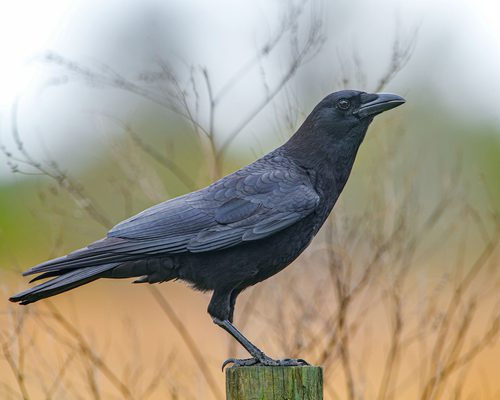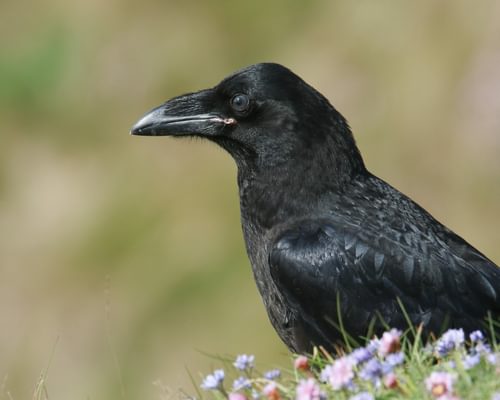Fish Crow
Corvus ossifragus
Visual Identification
Appearance
The Fish Crow is a medium-sized corvid with glossy black plumage that shows a subtle purple sheen in good light. It has a slender build, with a relatively small head and a thin, slightly curved bill shorter than the American Crow's.
Juveniles appear similar to adults but may have a duller plumage and less glossy feathers. There's no significant difference between males and females in appearance.
Size
Length
36cm to 41cm
Wingspan
84cm to 91cm
Weight
230g to 400g
Colours
Males and females have similar plumage
Primary Colour
Black
Secondary Colour
Purple
Beak Colour
Black
Leg Colour
Black
Habitat and Distribution
Habitats
Woodland
Garden
Wetland
Coastal
Urban
Farmland
Grassland
Desert
Tundra
Rainforest
Mountain
Savanna
Distribution
Fish Crows are primarily found along the eastern and southeastern coasts of the United States, from New England to Florida and west along the Gulf Coast to Texas. They inhabit coastal areas, estuaries, and inland waterways. Populations have expanded into Canada, especially along Lake Ontario.
While mostly coastal, they have expanded their range inland along major rivers and lakes. In the USA, they're common in coastal cities and towns, adapting well to urban environments near water bodies.
Elevation Range
Up to 500 meters
Climate zones
Temperate, Subtropical
Distribution Map
This map gives you a rough idea of where you might spot a Fish Crow. The coloured areas show countries where these birds have been seen.
A few things to keep in mind:
- Birds might not be everywhere in the coloured areas, for example, they may be present around the coast of that country
- Where birds live can change with seasons and available food
- This map is quite simple - it doesn't show exact locations
We're working on making our maps even better! Soon, we hope to show you:
- More detailed maps for bigger countries, including state and region
- How birds move around during different seasons
Distribution by Region
Behaviour and Ecology
Bird Attributes
This feature is in beta. We'd love your feedback to improve it!
Share your thoughtsBird Attributes Explained
Our bird attributes system rates various aspects of a bird's capabilities on a scale of 0-100, based on data from field observations, scientific studies, and expert knowledge.
Attribute Categories:
- Agility: Manoeuvrability, speed, and grace in flight or movement.
- Strength: Physical power, often correlating with size and hunting abilities.
- Adaptability: Ability to thrive in various environments or changing conditions.
- Aggressiveness: Territorial behaviour and assertiveness, particularly during breeding seasons.
- Endurance: Stamina, often seen in migration patterns or foraging behaviours.
Understanding the Ratings:
- 0-20: Very Low
- 21-40: Low
- 41-60: Average
- 61-80: High
- 81-100: Very High
Remember, these attributes are relative to other bird species and don't necessarily indicate superiority.
Hover over the icon next to each attribute for more information.
Tap the icon next to each attribute for more information.
Agility
Reflects the bird's manoeuvrability, speed, and grace in flight or movement.
Fish Crows demonstrate high agility with their adept flight skills, often seen soaring and gliding over water bodies. Their ability to manoeuvre swiftly, especially when following fishing boats or foraging along shorelines, indicates impressive aerial dexterity.
Strength
Indicates the bird's physical power, often correlating with size and hunting abilities.
Whilst not exceptionally strong for their size, Fish Crows possess moderate strength. Their ability to carry and drop shellfish from heights to crack them open suggests a decent level of physical power, though not extraordinary compared to larger corvids.
Adaptability
Represents the bird's ability to thrive in various environments or changing conditions.
Fish Crows exhibit remarkable adaptability. They've successfully expanded from coastal habitats to inland waterways and urban environments. Their opportunistic foraging behaviour, including tool use and exploitation of human food sources, demonstrates high adaptability to various conditions.
Aggressiveness
Measures the bird's territorial behaviour and assertiveness, particularly during breeding seasons.
Fish Crows show moderate aggressiveness. Whilst they're known to steal fish and bait, indicating some boldness, they're not typically described as highly aggressive birds. Their social nature suggests a balance between assertiveness and cooperation within their species.
Endurance
Reflects the bird's stamina, often seen in migration patterns or foraging behaviours.
The Fish Crow's endurance appears to be quite good. Their ability to forage over wide areas, including following fishing boats and patrolling shorelines, indicates solid stamina. However, as primarily coastal birds, they may not undertake the long-distance migrations seen in some other species, which limits their endurance rating.
Diet
Fish Crows have a varied diet, primarily consisting of small fish, crustaceans, and mollusks found in coastal waters. They also consume insects, small reptiles, bird eggs, and nestlings. Opportunistic feeders, they readily take advantage of human food scraps in urban areas.
Behaviour
Fish Crows are highly social birds, often seen in small flocks or pairs. They're known for their agile flight, frequently soaring and gliding over water bodies.
These intelligent birds are opportunistic foragers, often following fishing boats or scavenging along beaches and waterfronts.
Vocalisation
The Fish Crow's call is distinctively nasal and short, often described as a two-note 'uh-uh' or 'ca-ha'. It is higher-pitched and less harsh than the American Crow's 'caw'. The Fish Crow also produces a variety of softer croaks, rattles, and guttural sounds in social interactions.
Nesting & Breeding
Fish Crows typically form monogamous pairs and breed from March to June. They engage in courtship displays that include aerial chases and mutual preening.
Nests are built in trees or large shrubs, often near water. They are a bulky structure of sticks lined with softer materials like grass and bark. Females lay 3-5 pale blue-green eggs with brown spots.
Both parents incubate the eggs for about 16-18 days. Nestlings fledge after approximately 30-35 days but may remain dependent on parents for several more weeks.
Conservation and Status
Global Conservation Status
While the Fish Crow is currently listed as Least Concern, it faces threats from habitat loss due to coastal development and climate change.
Local populations may be affected by pollution in aquatic ecosystems, which can impact their food sources.
Population Data
Global Population Estimate
Unknown
Birdwatching Tips
- Look for Fish Crows near coastal areas, rivers, and lakes
- Listen for their distinctive nasal 'uh-uh' call, which differs from the American Crow's 'caw'
- Observe their behavior around water, including following boats and foraging on shorelines
- Note their slightly smaller size and more slender build compared to American Crows
Additional Information
Quick Facts
Family:
CorvidaeAverage Lifespan
7 to 10 years
Predators
Main predators include large raptors such as Great Horned Owls, Red-tailed Hawks, and occasionally Peregrine Falcons. Raccoons and snakes may prey on eggs and nestlings.
Did You Know?
- Fish Crows can open shellfish by dropping them from heights onto hard surfaces.
- They're known to steal fish from fishing lines and bait from crab pots.
- Fish Crows have been observed using tools like sticks to probe for food.
Similar Birds
References
- 1
website: BirdLife International. 2016. Corvus ossifragus. The IUCN Red List of Threatened Species 2016: e.T22705993A94045235.
View source - 2
report, 2007: Breeding Bird Survey and/or Christmas Bird Count: Butcher and Niven
Share Your Feedback
We value your opinion! Let us know what you think about this bird page.

